Health
 It is with great sadness that our family heard the news yesterday about our cousin, Larry Hein’s passing. Larry was the oldest child of my husband, Bob’s Uncle Eddie and Aunt Pearl Hein. Eddie passed away just three month and two weeks ago. Larry is dad to Dalton and Destiny, brother to Kim Arani, and brother-in-law to Mike Arani. It has been a rough few months for this family. My heart just aches for all of them.
It is with great sadness that our family heard the news yesterday about our cousin, Larry Hein’s passing. Larry was the oldest child of my husband, Bob’s Uncle Eddie and Aunt Pearl Hein. Eddie passed away just three month and two weeks ago. Larry is dad to Dalton and Destiny, brother to Kim Arani, and brother-in-law to Mike Arani. It has been a rough few months for this family. My heart just aches for all of them.
Larry was born and raised in Forsyth, and never really thought about going anywhere else. I remember on the visits my husband, Bob and our family took to visit our Forsyth family, Larry loved spending time with his cousins. Grandma and Grandpa 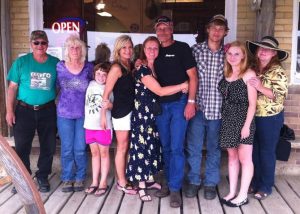 Hein has a ranch north of Forsyth, and the grandkids all loved to go out and play. There were three of the younger grandkids, Larry, Scott, and Kim Hein, and they spent as much time at their grandparents’ house as they could. It’s the normal way of kids, isn’t it. Whenever we went to visit, my kids couldn’t wait to play with their cousins. Even though Larry, Scott, and Kim were older than my girls, Corrie and Amy, they all played the kinds of games the younger kids wanted to play, and I always found that a sweet thing for
Hein has a ranch north of Forsyth, and the grandkids all loved to go out and play. There were three of the younger grandkids, Larry, Scott, and Kim Hein, and they spent as much time at their grandparents’ house as they could. It’s the normal way of kids, isn’t it. Whenever we went to visit, my kids couldn’t wait to play with their cousins. Even though Larry, Scott, and Kim were older than my girls, Corrie and Amy, they all played the kinds of games the younger kids wanted to play, and I always found that a sweet thing for  those kids to do. I miss those days.
those kids to do. I miss those days.
Larry was a mechanic in Forsyth, Montana, where he owned Hein Repair for a number of years now. He worked on just about anything that needed repair. He was a great dad, brother, and son. He was an asset to his community, and well liked by all who knew him. Yesterday, a heart attack took Larry from all those who loved him, and left an empty place in all our hearts. We are all now left to pick up the pieces of yet another heartbreaking loss in the family. My thoughts go out to this precious family. I am praying for comfort for all of them as they grieve this new loss and comfort each other on this sad time. Rest in peace Larry until we all meet again. We love and miss you very much.

 Alec Todd Olsen came into our lives just under three months ago. Hardly enough time to really get to know him, but in the short little bit of time that he was with us, he snuggled his way deep into our hearts. His darling face, and his sweet smile captivated all of us. Alec was the first child of my grand-niece, Siara Olsen and her husband, Nick. He was long awaited and very loved. He was, as his mommy called him, a sweet little ray of sunshine, and everyone who met him would agree.
Alec Todd Olsen came into our lives just under three months ago. Hardly enough time to really get to know him, but in the short little bit of time that he was with us, he snuggled his way deep into our hearts. His darling face, and his sweet smile captivated all of us. Alec was the first child of my grand-niece, Siara Olsen and her husband, Nick. He was long awaited and very loved. He was, as his mommy called him, a sweet little ray of sunshine, and everyone who met him would agree.
There was no doubt…Alec was a happy baby. He loved to smile at people, especially his parents, and to see people smile back at him. He was really starting to notice things going on around him, but his favorite thing to do was to snuggle with his parents…and usually fall fast asleep. Nevertheless, the ray of sunshine still radiated from little Alec.
Alec left us to go to Heaven on January 25th, when his little body could no longer fight RSV. It was a heartbreaking day for all of Alec’s family. When I visited his parents yesterday, was reminded of other parents who had lost children. The only way to put the look…is a parent’s heart and empty arms. It should never happen to any parent. Our kids are supposed to outlive us. There is no greater pain that anyone can go through, and my heart aches for these precious parents.
Of course, we know that Alec is in Heaven now, safe and healthy…and most of all happy. He would want his parents to know that they needn’t worry…if he could talk to them. And they know that too, but it is so hard to be the ones left behind to pick up the pieces. The pain will never leave. Anyone who has experienced loss 
 knows that, and the reality is that you don’t get over this. Those of us, who love Siara and Nick, can only be there to support them, hold them while they cry, and just let them show us what they need, which they might not even know yet. You never get over this, you can only get on with it…life. Alec can’t come back, and we can’t go to him…yet, but he will be waiting when we can. Rest now sweet little Alec Todd Olsen, and know that we love and miss you very much, and we cant wait to see you again in Heaven. Siara and Nick, we will be here for you…whatever and whenever you need.
knows that, and the reality is that you don’t get over this. Those of us, who love Siara and Nick, can only be there to support them, hold them while they cry, and just let them show us what they need, which they might not even know yet. You never get over this, you can only get on with it…life. Alec can’t come back, and we can’t go to him…yet, but he will be waiting when we can. Rest now sweet little Alec Todd Olsen, and know that we love and miss you very much, and we cant wait to see you again in Heaven. Siara and Nick, we will be here for you…whatever and whenever you need.
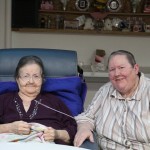 For the over 45 years that I have known my husband’s aunt, Margee Kountz, I have understood that she is the rock of her family. I say that I understood it, because over the years I have watched as different events have unfolded within her family, and it is Margee who always steps in to hold the family together. Margee was a single mom for most of her children, Dan and Sandy’s lives. Her children and grandchildren, and now great grandchildren have always been the joy of her life. Margee’s life has not been without loss…a daughter-in-law and a grandson, plus her parents, and both of her sisters. Margee is the last one of her generation in her family who is still living.
For the over 45 years that I have known my husband’s aunt, Margee Kountz, I have understood that she is the rock of her family. I say that I understood it, because over the years I have watched as different events have unfolded within her family, and it is Margee who always steps in to hold the family together. Margee was a single mom for most of her children, Dan and Sandy’s lives. Her children and grandchildren, and now great grandchildren have always been the joy of her life. Margee’s life has not been without loss…a daughter-in-law and a grandson, plus her parents, and both of her sisters. Margee is the last one of her generation in her family who is still living.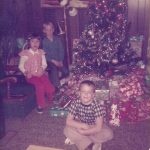
Margee stepped in to help raise her son’s two children, and to give them a stable life. She also helped to raise her daughter’s three children. I learned when I had my own grandchildren that with working parents, it takes a village to raise a child. Our kids need “involved” grandparents, and I can’t think of a greater blessing for a grandparent than spending time with their amazing grandkids. Margee has been a great help to her kids and grandkids, and they are very close to Margee, even as adults.
These days, the grandkids are the ones to help Margee. As her health isn’t as good 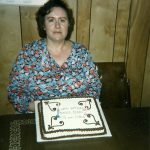 as it was, she sometimes needs help with things. Because of the close relationship the grandkids have had with Margee, they are happy to help her. They love her after all, and anyone who knows Margee, and what a loving and caring person she is, can see exactly why they love her. Margee is the person who would give you her last nickel, if you needed it.
as it was, she sometimes needs help with things. Because of the close relationship the grandkids have had with Margee, they are happy to help her. They love her after all, and anyone who knows Margee, and what a loving and caring person she is, can see exactly why they love her. Margee is the person who would give you her last nickel, if you needed it.
For as long as I have known her, I have felt very blessed by her. From her cake decorating years, during which we could count on the best looking cakes for parties, to her willingness to help with any event that was being held, made her a valued member of our family…and one we never want to be without. Today is Margee’s birthday. Happy birthday Margee!! Have a great day!! We love you!!

 You hear it a lot, especially on television shows. Doctors, nurses, police, firefighters, and paramedics are all told not to get personally involved. Those who instruct them not to get personally involved with their ill patients are, of course, trying to protect them from the inevitable grief of losing a patient, but being on the other side of that equation, I must say that when they do get personally involved, it is better for all.
You hear it a lot, especially on television shows. Doctors, nurses, police, firefighters, and paramedics are all told not to get personally involved. Those who instruct them not to get personally involved with their ill patients are, of course, trying to protect them from the inevitable grief of losing a patient, but being on the other side of that equation, I must say that when they do get personally involved, it is better for all.
For one thing, I think that most of the time, it is impossible for one human being, taking care of another human being, not to become personally involved. Because of their training, these professionals try not to get too close, but I don’t think many succeed, even when they only have a patient for a few days or even minutes. Sometimes it’s not so much the patient that tugs at there hearts, but rather the worried family members who are in need of comfort. For most family members there is nothing more helpful than an encouraging word, and yes, even a hug, when things seem to be falling apart.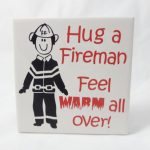
In the years that I have taken care of my parents, my in-laws, my sister-in-law, and my husband, I have had more than my share of dealings with ambulance and fire department EMTs, as well as doctors, nurses, and CNAs. The ones I remember the most, were the ones who got personally involved. They knew when my worried spirit needed a hug…just so I could stay on my feet. There is nothing more important, than the moments when the ambulance crew has loaded up your loved one, and you are left in the house with the fire department EMTs in your living room picking up their gear. You suddenly realize that your loved on is in the hands of someone else. You can’t do anything more to help. You find yourself just standing there feeling very much alone, and suddenly very small. I guess I must have looked very fragile at those moments, because invariably, one of those wonderful firemen put their arms around me, and told me that everything was going to be ok. It doesn’t matter how big or small the firefighter was, him standing there in those bunkers made him feel very 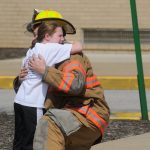
 substantial. Those strong arms around me, allowing me to cry, made all the difference. I don’t know how that hug affected the firefighter, but I know that after one of those big hugs from that angel of a firefighter, I was able to wipe away my tears, pull myself up by the bootstraps, and head to the hospital, where I was needed to answer questions about my loved one’s health…questions that would make it easier for the doctors and nurses to give my loved ones better care, so they can save their lives. Sometimes, the first responders make the most difference…and that can make all the difference.
substantial. Those strong arms around me, allowing me to cry, made all the difference. I don’t know how that hug affected the firefighter, but I know that after one of those big hugs from that angel of a firefighter, I was able to wipe away my tears, pull myself up by the bootstraps, and head to the hospital, where I was needed to answer questions about my loved one’s health…questions that would make it easier for the doctors and nurses to give my loved ones better care, so they can save their lives. Sometimes, the first responders make the most difference…and that can make all the difference.
 After being honorably discharged from the Navy, my niece, Gaby Beach, who married my nephew Allen Beach on September 24, 2014, started working while Allen when to college to get his degree. Once he was finished, the plan was for Allen to work while Gaby went to school to get her degree. It was a good plan, because it allowed each of them to study hard, without having to work. They could devote themselves to their studies. While Allen now works as the department manager over referral, communications, ambulances, Gaby is getting ready to begin her second year of nursing school. Having worked as a corpsman in the Navy, nursing is a perfect next
After being honorably discharged from the Navy, my niece, Gaby Beach, who married my nephew Allen Beach on September 24, 2014, started working while Allen when to college to get his degree. Once he was finished, the plan was for Allen to work while Gaby went to school to get her degree. It was a good plan, because it allowed each of them to study hard, without having to work. They could devote themselves to their studies. While Allen now works as the department manager over referral, communications, ambulances, Gaby is getting ready to begin her second year of nursing school. Having worked as a corpsman in the Navy, nursing is a perfect next  step for Gaby, who was a very good corpsman.
step for Gaby, who was a very good corpsman.
These days, when she’s not studying, Gaby has become very interested in house plants. She has a green thumb, and loves plants. She has decided to complete the “Let’s Grow Together In 2020” initiative. I looked over the program, and it would be really a cool thing to do…if I didn’t have a decidedly brown thumb. Unlike me, Gaby has a real knack for plants, and for arranging them. I know that her plants will beautify their home, and make it a healthier place too. Plants a good to have in the home…as long as you can keep them alive, that is. Gaby can do just that, and her plants are thriving. Her day 8 plant…the fastest grower was the Epipremnum Pinnatum or “Cebu Blue,” names I wouldn’t have known, had Gaby not posted them. I may not know much about plants, but I have enjoyed seeing Gaby’s  posts about her adventures with them, and I look forward to the future posts as well.
posts about her adventures with them, and I look forward to the future posts as well.
Gaby ability to raise plants isn’t surprising, because she has a real knack for all living things. I am reminded of her work with therapy dogs during her Navy years. I’m ok with dogs, but I can’t say I’m “comfortable” with dogs. Cats yes, dogs…not so much. Gaby, on the other hand, is a natural. Dogs just instinctively love Gaby, as much as she loves them. And I think everyone in our family can understand that, because we have all come to love Gaby too. She brightens our world every time we see her. Today is Gaby’s birthday. Happy birthday Gaby!! Have a great day!! We love you!!
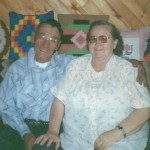
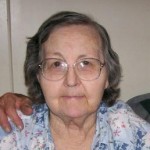 It seems impossible to me that my mother-in-law, Joann Schulenberg could be gone now for two years. She was such a fighter, when it came to her health. There were a number of times that we thought we had lost her, but she always bounced back…until she didn’t. The end of her days had come, and with it, there were no parents in our lives again. My parents, Al and Collene Spencer and my father-in-law, Walt Schulenberg were gone, and now my mother-in-law had joined them in Heaven. It felt empty here on earth. The loss hit hard with each of my four parents, but with my mother-in-law, there was also the finality of it. We had no more parents. We, their children, are the matriarchs and patriarchs of our families now, but it feels like we are orphans. The knowledge that you have no parents, really brings that orphaned feeling home.
It seems impossible to me that my mother-in-law, Joann Schulenberg could be gone now for two years. She was such a fighter, when it came to her health. There were a number of times that we thought we had lost her, but she always bounced back…until she didn’t. The end of her days had come, and with it, there were no parents in our lives again. My parents, Al and Collene Spencer and my father-in-law, Walt Schulenberg were gone, and now my mother-in-law had joined them in Heaven. It felt empty here on earth. The loss hit hard with each of my four parents, but with my mother-in-law, there was also the finality of it. We had no more parents. We, their children, are the matriarchs and patriarchs of our families now, but it feels like we are orphans. The knowledge that you have no parents, really brings that orphaned feeling home.
My mother-in-law, was a homemaker for most of her life, and very skilled in things like cooking, sewing, knitting, crocheting, and canning. These were things she passed down to her daughters, and to me. Of course, my own mother taught me part of these things too, but we didn’t can often, other than making jelly, and the things my mother-in-law cooked were different from my own mom, so that added variety to my abilities. My mother-in-law, was probably best known for her sewing, knitting, and crocheting. She sold many of her crafts at craft fairs over the years, adding to the family budget and to her craft budget as well. She also loved to bake, and her “Murder Cake” was a family favorite.
My in-laws lived in the country for most of the time I knew them, but they moved to town in the last years of their lives. While she preferred the quiet of the country, my mother-in-law did enjoy watching all the activity that took place near their home at the corner of two busy streets in In her later years, my mother-in-law developed Alzheimer’s Disease. Casper. After she had to be moved to Shepherd of the Valley nursing home, she 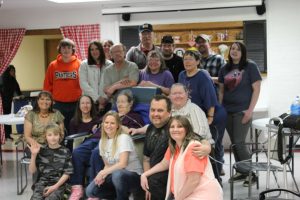 enjoyed the activity there, especially at the nurses station, because she was a “people watcher” all her life. She liked to see what everyone around her was up to, and figure it all out, even wondering why they spoke to the people they did, or did the things they did. I was glad that her curiosity never left her. It made her time in the nursing home must more interesting. Finally, on January 4, 2018, she lost her health battle. Like most Alzheimer’s patients, it was not the disease that took her, but rather that her kidneys gave out. She passed peacefully that evening, after having her family around her earlier in the day. She simply went to sleep, and went home. While we were so sorry to see her go, we knew she was tired of fighting. We love and miss her very much.
enjoyed the activity there, especially at the nurses station, because she was a “people watcher” all her life. She liked to see what everyone around her was up to, and figure it all out, even wondering why they spoke to the people they did, or did the things they did. I was glad that her curiosity never left her. It made her time in the nursing home must more interesting. Finally, on January 4, 2018, she lost her health battle. Like most Alzheimer’s patients, it was not the disease that took her, but rather that her kidneys gave out. She passed peacefully that evening, after having her family around her earlier in the day. She simply went to sleep, and went home. While we were so sorry to see her go, we knew she was tired of fighting. We love and miss her very much.

 It hardly seems possible that it can be two years ago already, that our family’s little Reece Balcerzak arrived in what was destined to be the beginning of a long time away from home for her parents, while they waited in Denver for their daughter to get strong enough to go home. It was a tough time, with an amazing ending. The little family came home victoriously with their precious girl. I guess that makes her middle name very much appropriate…Victoria, which means “victory” in Latin.
It hardly seems possible that it can be two years ago already, that our family’s little Reece Balcerzak arrived in what was destined to be the beginning of a long time away from home for her parents, while they waited in Denver for their daughter to get strong enough to go home. It was a tough time, with an amazing ending. The little family came home victoriously with their precious girl. I guess that makes her middle name very much appropriate…Victoria, which means “victory” in Latin.
Reece has so much more going for her than just her name, however. The little girl is not only a fighter, but she smiles more than just about anyone else I have ever seen. It is amazing that a little girl who has been through such a tough beginning can be so filled with joy, but then I guess that it was her parents and family who actually went through all that. Reece was just there, smiling at everyone through it all. Even as a tiny…and I really mean tiny…girl, she was filled with joy and always smiling. I find that so awesome!!
Since her very early arrival at 28 weeks into her mother, Katie’s pregnancy, Reece has been going at break-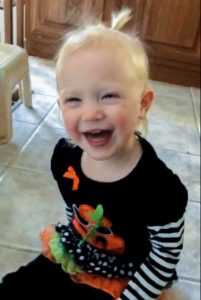
 neck speed to make up for the time she spend in the hospital in Denver. She is a very busy little girl. She never ceases to amaze all who know her. Her parents don’t really need much in the way of entertainment, because their daughter is really good at that. She is talking very well now, and chatters about the things that interest her, some of which we probably have no idea, because they are her happy things alone. Ahhh, the life of a child. To have such innocence, and such joy with the things around you. Reece has such a bright future ahead of her…so many things to learn and to explore. It will be exciting for us, her family, to watch this happy, smiley girl as she grows into the wonderful adult she will one day become. Keep smiling smiley girl. We love it. Today is Reece’s 2nd birthday. Happy birthday Reece. Have a great day!! We love you!!
neck speed to make up for the time she spend in the hospital in Denver. She is a very busy little girl. She never ceases to amaze all who know her. Her parents don’t really need much in the way of entertainment, because their daughter is really good at that. She is talking very well now, and chatters about the things that interest her, some of which we probably have no idea, because they are her happy things alone. Ahhh, the life of a child. To have such innocence, and such joy with the things around you. Reece has such a bright future ahead of her…so many things to learn and to explore. It will be exciting for us, her family, to watch this happy, smiley girl as she grows into the wonderful adult she will one day become. Keep smiling smiley girl. We love it. Today is Reece’s 2nd birthday. Happy birthday Reece. Have a great day!! We love you!!
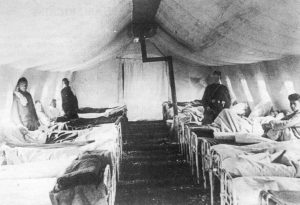
 As nursing goes, I suppose you could say that World War I changed everything. War is an ugly business, and wounded men (and women these days) are just a part of the unavoidable side effects of it. As the upheaval of World War I changed the world, so the horrors of it, changed nursing.
As nursing goes, I suppose you could say that World War I changed everything. War is an ugly business, and wounded men (and women these days) are just a part of the unavoidable side effects of it. As the upheaval of World War I changed the world, so the horrors of it, changed nursing.
From 1914 to 1918, what was dubbed “the war to end all wars” in the innocence of the times, anyway…led to the mobilization of more than 70 million military personnel, including 60 million Europeans, making it one of the largest wars in history. As we know, it was hardly the war to end all wars, but it did change many of the things we had come to expect war to be. World War I was one of the deadliest conflicts in history. The death toll is staggering…estimated nine million combatants and seven million civilian deaths, as a direct result of the war. To add to that total, came the resulting genocides, as well as the 1918 influenza pandemic, which caused another 50 to 100 million deaths worldwide.
Now, just imagine being a nurse in those days. Of course, medical tents and hospitals were close to the perimeter of the fighting, to care for hurt soldiers quickly. This assured that the World War I nurses were witness to the conflict firsthand. I seriously doubt if any of them walked away from the war with less PTSD than the soldiers did. Many of them wrote about their involvement in diaries and letters that, similar to photographs from this time, offer insight into how they were personally impacted. The journals also include details about fighting, disease, and the hope that nurses and soldiers alike found in their darkest moments…if there could be any hope to be found.
It was in World War I that Germany introduced gas as a new form of aggression in 1915. It was in many ways the latest form of terrorism. To say that it was a different level of engagement seems an understatement. Gas devices became commonplace. They were worn anytime an air raid siren sounded, and some people wore them much of the time, as a precaution. The soldiers didn’t go anywhere without their gas mask. It was their life-line. Still, they were among the most feared elements of World War I.
“Sister Edith Appleton was a British nurse who served in France during World War I. She wrote about the soldiers stricken by gas and the adverse physical impacts they endured. The minimal immediate effects are tearing of the eyes, but subsequently, it causes build-up of fluid in the lungs, known as pulmonary edema, leading to death. It is estimated that as many as 85% of the 91,000 gas deaths in WWI were a result of phosgene or the related agent, diphosgene (trichloromethane chloroformate).”
Margaret Trevenen Arnold, a volunteer British Red Cross nurse in France in 1915 kept a diary of her time at Le Tréport and described “groans, and moans, and shouts, and half-dazed mutterings, and men with trephined heads suddenly sitting bolt upright… It was awful, and I really know now what [conflict] means.” These serious head injuries would most likely cause permanent brain damage for these men…if they survived at all.
Some hospital tents were eerily quiet, because the men in them were too sick to make a sound. Bandages were changed as often as every two hours, in an effort to ward off infection, and tourniquets to stop the bleeding until the soldier could be sent to surgery. Most of these field “hospitals” faced the same serious conditions…a lack of clean water and sterile surroundings. The nurses had to make due with what they had…and that often wasn’t much. Sometimes the lack of medicine became a major issue, especially when it came to anesthesia. Sometimes, the soldier had to simply force himself to remain calm, and steel himself to the inevitable pain of the surgery. These men had to place their faith in the doctors and nurses who cared for them, and they had not had time to even prepare for the need for surgery…let alone without anesthesia.
“Violet Gosset served on the Western Front from 1915 to 1919. While working at a hospital in Boulogne, France, Gosset kept notes about her experiences. She described a lack of supplies, overcrowded conditions, and scrapes that often resulted from a lack of adequate protection.”
“Helen Dare Boylston, an American nurse who served in France with the Harvard Unit medical team, had patients that spanned a wide range of age demographics. Some of the soldiers were just teenagers (“boys”), while others were in their 20s. However, Boylston recalled at least one soldier in his 60s (she called him “Dad”). Boylston saw the number of men in her care rise significantly in March 1918. At this time, she was sent…with two other nurses…to care for 500 soldiers. Boylston and her fellow nurses, including one named Ruth, quickly adapted to their conditions.”
Trench warfare was a shock to most of the soldiers. Still, most soldiers remained in good spirits. A part of nursing that might be considered a little different in the field hospitals is that the nurses are “in charge of” morale to a great degree. whether the men had Trench Foot, were sick, or wounded, they needed to have someone to lift their spirits. Who would have ever thought of nurses as morale boosters, but it was so.
Flu was widespread during World War I, even before the pandemic of 1918. After the pandemic began, things became critical. Now, nurses had to contend with treatment and prevention, in addition to other issues. One problem is that soldiers who ended up in medical tents and hospitals were often covered in mud, and flies frequently buzzed around them. Keeping germs at bay was next to impossible.
“Nurse Helen Dare Boylston was a keen observer of how soldiers reacted when they returned from the front, especially when they interacted with female nurses. She commented on the “fascinating game” of casual 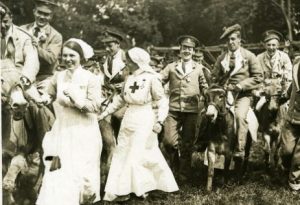
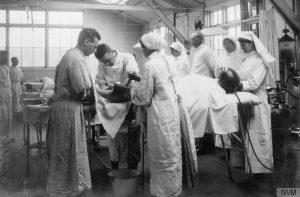 romance that commonly played out in the midst of conflict-related stress.” This was probably one of the most unusual phenomena, because nurses are told not to get emotionally involved, and yet here it was exactly what was needed. Nursing has changed over the years, but never has it been so evident as in World War I. It was as if nurses were making it up as they went along…and maybe they were.
romance that commonly played out in the midst of conflict-related stress.” This was probably one of the most unusual phenomena, because nurses are told not to get emotionally involved, and yet here it was exactly what was needed. Nursing has changed over the years, but never has it been so evident as in World War I. It was as if nurses were making it up as they went along…and maybe they were.
 It’s that time of year again, and Thanksgiving Day has arrived. The day will begin with much cooking, table setting, and other preparation. All too often we get so caught up in the preparation for the main meal of the day, and prepare for the gathering together of family and friends, that we forget the real purpose of the day…giving thanks for all we have been given.
It’s that time of year again, and Thanksgiving Day has arrived. The day will begin with much cooking, table setting, and other preparation. All too often we get so caught up in the preparation for the main meal of the day, and prepare for the gathering together of family and friends, that we forget the real purpose of the day…giving thanks for all we have been given.
Over the past year, some health issues have presented themselves, not only in our family, with my husband, Bob; but with my son-in-law, Kevin’s mother, Becky Skelton too. Both of them had heart issues, and now both of them are well again. You can’t emphasize too much, the importance of good health. Never is that importance made more clear, than when things happen that threaten that good health. The concerns we have all felt, each of us watching as another of our loved ones has worried over their mom or dad, husband or wife, brother or sister, were almost overwhelming. Now, that all the tests, the surgery, the procedure, and the recovery are behind us, we feel only thankfulness.
Our daughter, Corrie has been working hard in nursing school, and doing very well. She has been so blessed 
 with great grades, and a wonderful nursing school experience. I have watched her blossom throughout this process, and it warms my heart to see such an amazing transformation in her. She and Kevin have also been blessed with a granddaughter, who is their son, Chris and fiancée, Karen’s daughter. Their son Josh is very busy with two jobs, while waiting for the next college class that he needs to become an EMT. Eventually he will be going into firefighting.
with great grades, and a wonderful nursing school experience. I have watched her blossom throughout this process, and it warms my heart to see such an amazing transformation in her. She and Kevin have also been blessed with a granddaughter, who is their son, Chris and fiancée, Karen’s daughter. Their son Josh is very busy with two jobs, while waiting for the next college class that he needs to become an EMT. Eventually he will be going into firefighting.
Bob and I have been thankful to have been able to travel to visit our daughter Amy Royce and her family, and spend two weeks with them, including Independence Day, which was a new thing for us, since we have spent Independence Day in the Black Hills for many years. Spending quality time with Amy; Travis; Shai and her boyfriend, Jordan; and Caalab, and his girlfriend, Chloe, was a special time. Any amount of time spent with family is something to be thankful for. As our children, grandchildren, and now great granddaughter grow and become more busy, time is something that is often in short supply, and definitely a blessing.


Everyone has different reasons to be thankful all year long, but at this time of year, we tend to reflect on the many blessings we have been given all year…some are extra special, and others bring deep emotion, because we know what we might have lost. This Thanksgiving Day, I realize just how much I have to be thankful for, and for all of it, I thank God, the Father of Lights, from whom all good gifts come. I hope everyone has as much to be thankful for as I have this year. Happy Thanksgiving to all.
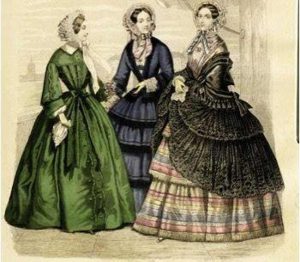
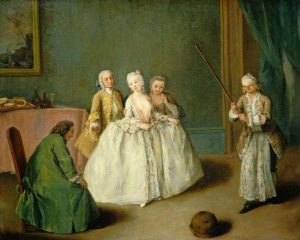 Women have always had an eye for fashion, but I can’t say that having an “eye” for fashion, is the same as having common sense for fashion. In the Victorian era, Bottle-green dresses were all the rage. I understand the love of the color green, and how a beautiful emerald green might be a coveted color. The problem occurs with the process of obtaining that color. The process used to achieve this lovely shade of green involved the fabric being dyed using large amounts of arsenic…yes, rat poison!! Some women suffered nausea, impaired vision, and skin reactions to the dye. They endured the suffering because the dresses were only worn on special occasions, thereby limiting exposure to the arsenic in the fabric. By contrast, it was the garment makers were the real sufferers. Many of them became very ill and even died to bring this trend to the fashionable set.
Women have always had an eye for fashion, but I can’t say that having an “eye” for fashion, is the same as having common sense for fashion. In the Victorian era, Bottle-green dresses were all the rage. I understand the love of the color green, and how a beautiful emerald green might be a coveted color. The problem occurs with the process of obtaining that color. The process used to achieve this lovely shade of green involved the fabric being dyed using large amounts of arsenic…yes, rat poison!! Some women suffered nausea, impaired vision, and skin reactions to the dye. They endured the suffering because the dresses were only worn on special occasions, thereby limiting exposure to the arsenic in the fabric. By contrast, it was the garment makers were the real sufferers. Many of them became very ill and even died to bring this trend to the fashionable set.
Another crazy style was known as Panniers, which comes from the French word “panier,” meaning “basket.” These were popular in the 17th and 18th centuries. The look involved a boxed petticoat to expanded the width of skirts and dresses. The contraption stood out on either side of the waistline…straight out!! Panniers varied in size and were made of whalebone, wood, metal, and sometimes reeds. Extremely large panniers were worn mostly on special occasions and reflected the wearer’s social status. Even the servants wore them, though in a much smaller version. Two women couldn’t walk through an entrance at the same time or sit on a couch together, because their panniers took up an entire extra seat or more. The device was also uncomfortable, limiting movement and activity.
In the 1910s, French designer Paul Poiret, who was well known as “The King of Fashion” in America, debuted the hobble skirt. The long, close-fitting skirts forced women who wore them to adopt mincing, tiny steps. True, Poiret’s design liberated women from heavy petticoats and constricting corsets. But as he said, “Yes, I freed the 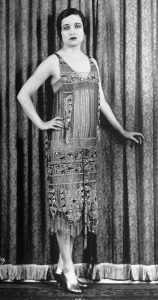
 bust. But I shackled the legs.” This makes me wonder why women allow their fashion ideas to come from men…who don’t have to wear the clothes they design. Some of these “fashions” were enough to make a woman faint, because her corset was too tight, and she could not get sufficient air.
bust. But I shackled the legs.” This makes me wonder why women allow their fashion ideas to come from men…who don’t have to wear the clothes they design. Some of these “fashions” were enough to make a woman faint, because her corset was too tight, and she could not get sufficient air.
During the Roaring ’20s, women no longer wanted the hourglass shape. Now the style was the boyish flapper figure. Underwear had to change to assist in this new look, and women who were “busty,” had a big problem and the underwear needed a big overhaul. The goal of every undergarment was to flatten the breasts and torso, so that flapper dresses could hang straight down without any curvaceous interruptions. Corset-makers R. and W.H. Symington invented a garment, the Symington Side Lacer, that would flatten the breasts. The wearer would slip the garment over her head and pull the straps and side laces tight to smooth out curves. Other manufacturers designed similar devices. The Miracle Reducing Rubber Brassiere was “scientifically designed without bones or lacings,” while the Bramley Corsele combined the brassiere and corset into one piece that easily layered under dresses. I wonder how anyone could breathe in these prisons known as underwear.
The Crinoline, also known as the hoop skirt, was a bell-shaped device that pushed the volume of skirts to an extreme degree. Worn in the 1800s by Victorian women, Crinolines were originally petticoats made of linen stiffened with horsehair. Wonderful…now we are wearing horsehair under our skirts. This created a big problem. It was just too hot with so many petticoats. Later, the invention of the steel cage crinoline offered the same voluminous look without the extra heat and bulk of thick petticoats. These undergarments were clumsy and hard to control, but they were also dangerous. In 1858, a young woman in Boston died when her large skirt caught embers from a fireplace in her parlor and went up in flames. It all happened to fast to save her. Nineteen such deaths occurred in a two-month period. That is a heavy price to pay in the name of fashion.
And then, there was the “Grecian bend,” the Victorian bustle. It arrived on the scene in the 1870s. The earliest version of this trend simply featured excess fabric gathered and draped at the back of a dress. Eventually, though, skirts were puffed up with large cushions filled with straw. Ladies who wore them ended up with exaggerated figures with outthrust hindquarters. The bustle was frequently a target of ridicule. This style 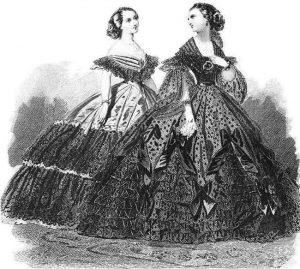
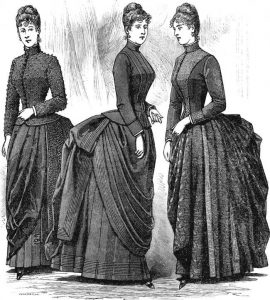 reminds me of the “padded seat” of modern day leggings, though the modern day version isn’t quite so exaggerated. In 1868, Laura Redden Searing, using the pen name Howard Glyndon, wrote about the agony young women put themselves through for fashion in the New York Times, “If you knew the Spartan courage which is required to go through an ordeal of this sort for two or three hours at a time, you would not wonder that she has not an idea left in her head after her daily display is over,” she said. Hahahaha!! That sounds reasonable to me.
reminds me of the “padded seat” of modern day leggings, though the modern day version isn’t quite so exaggerated. In 1868, Laura Redden Searing, using the pen name Howard Glyndon, wrote about the agony young women put themselves through for fashion in the New York Times, “If you knew the Spartan courage which is required to go through an ordeal of this sort for two or three hours at a time, you would not wonder that she has not an idea left in her head after her daily display is over,” she said. Hahahaha!! That sounds reasonable to me.

